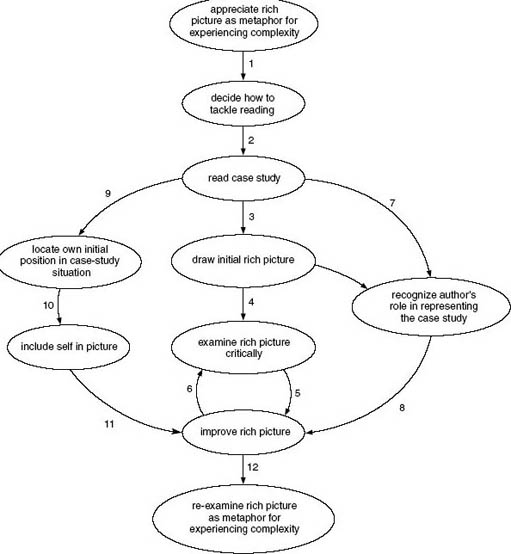6 Part 2: 2 Immersing yourself in complexity
The first three activities in Figure 4 are to plan a strategy, then to immerse yourself in an example of complexity, and then represent that complexity through drawing a rich picture. I've selected a rich picture as the focus of this task because it is a means of bringing you into a rich encounter with the complexity of the situation described. The rich picture is a representation of your encounter with the situation, and so drawing a complete rich picture needs you to have represented the situation to yourself. The rich picture allows you to see the whole situation at once – something that would be very difficult to do in your head. My purpose is to offer the encounter, and then to consider the experience of the encounter, between you and the complexity. The rich picture is simply the means and the evidence of this happening. Bear this in mind as you work through the sequence of activities represented by Figure 5. Figure 5 is an unfolding of the first two activities of the overall task of experiencing complexity described by Figure 4.

At this point, I would like you to prepare for reading the case study, the second activity in Figure 5. Your task is simply to grasp as much of the case-study complexity as you can. Notice that, at this stage I am not suggesting you do any analysis of the situation described. At the end of this task you should only aim to have a general impression of the overall complexity and a representation of that complexity. Detailed study and analysis will come later. The case study is about 9500 words long. The next activity should help you decide how to tackle this reading.
There are a number of things in planning how to deal with this amount of material. Firstly, you may not be able to grasp all the detail at the first reading. Don't worry about this. The case study was chosen, in part, because the feeling of being overwhelmed is quite a common one in systems practice and the I thought this would give you some of that experience. Even if you feel overwhelmed, don't be discouraged. The later activities are proven ways of dispelling the sense of being overwhelmed. A bit of determination to get through it all will help.
Spend about five minutes on this activity.
Activity 9
How do you read most effectively?
It may be helpful to think of a specific experience where you were trying to understand a detailed piece of text. Did you have a strategy for reading it? What was that strategy? Does your strategy involve skim reading first to get an overall sense of the shape and returning to the beginning for a more careful read and then, finally, a third pass taking notes about the development of the narrative? Or perhaps your strategy, completely different from the first, involves a process of careful reading taking notes, followed by a second read-through to check the notes are as complete as they can be. Be as specific as you can in identifying a strategy that works for you. Make a list of the sequence of processes you anticipate will work well for you.
You should also assemble materials for drawing a rich picture.
Once you have identified a style of text-reading you think will work well for you, move on to the task of reading the case study. The case study was chosen because it is a real-life example of a complex situation where an attempt to put right a problem had results nobody intended. It also contains lots of soft complexity. So-called soft complexity is often the hardest to deal with since it involves human values, beliefs and emotions. In this case study, all of these collide.
Expect to take a total of around 5 hours to complete the next activity but if this unit is your first serious engagement with systems work, allow rather longer. You will need to get to grips with the concept of diagramming and, the concept of drawing rich pictures in particular. Don't attempt to tackle the task in one long session. You may get more out of it if you take it in two blocks of time, perhaps on consecutive evenings.
Activity 10
Read the case study ‘Financial support for the children of lone parents’ by Joyce Fortune (attached below) and draw a rich picture. (You can find some extra guidance on how to create a rich picture at this link [Tip: hold Ctrl and click a link to open it in a new tab. (Hide tip)] .)
Using your chosen style of reading, read through the case study and represent the situation in a rich picture. Make sure your rich picture is as rich as you can make it. Remember a rich picture is not intended to be an analysis. If you have any thoughts and ideas about the situation, or your rich picture of it, make a note of them so you won't forget but concentrate on the main task of representing as much of the situation as you can in the rich picture.
Click on the link below to read Appendix B.
